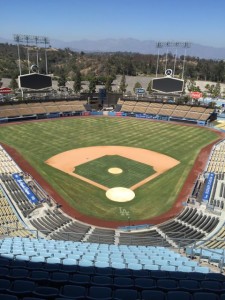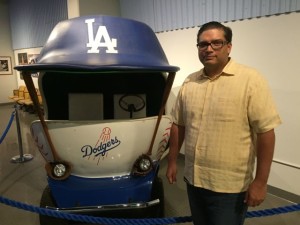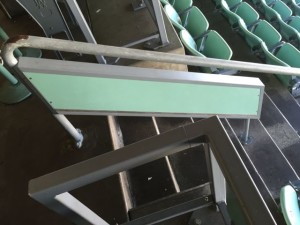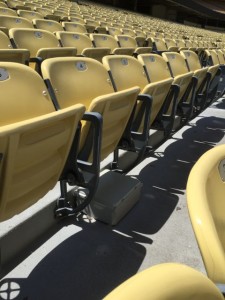
Dodgers Stadium, the SoCal baseball shrine. All photos: Terry Sweeney, MSR (click on any photo for a larger image)
Esquibel faced multiple challenges with Dodger Stadium. First, there was all that concrete to push signals through or around. There was the size of the Chavez Ravine venue and its far-flung parking lots, spanning more than 350 acres. The stadium also has few overhangs, a favorite place to attach Wi-Fi access points or distributed antenna system (DAS) gear. Then there’s Dodger Stadium’s capacity — 56,000 seats – the largest in the league and almost 30 percent larger than the average MLB stadium (42,790).
Esquibel’s biggest hurdle? ” Trying to achieve the network that we wanted but also maintain an appropriate budget for the solution,” he said. While Esquibel would not specify what the Dodgers spent, he did allow that it was “an 8-figure project.”
Coverage challenges in the best seats
Initially, the best seats in the house presented a coverage challenge; field and club level seats along the third- and first-base lines and the dugout lack any overhangs. So while phones in those sections could receive a short, directional beam sent from across the outfield, the upstream signal couldn’t get back to the AP across the field, said Esquibel.
“We wanted to guarantee a premium experience, regardless of the seat,” said Esquibel, who joined the Dodgers 6 years ago after working in IT at Toyota and Honda. So by using what he calls “a hybrid approach,” Wi-Fi APs and antennas are installed overhead where possible, but also under seats and in staircase handrails that divide the stadium’s steep aisles.All told, nearly 1,000 APs from Cisco and Aruba Networks blanket Dodger stadium, its concession areas and parking lots. Horizon Communications helped the Dodgers with design and installation of the Wi-Fi and DAS.
The under-seat APs/Wi-Fi antennas on the club level are housed in NEMA enclosures about every 15 seats, set eight rows apart. Esquibel was concerned about losing real estate under those seats; he also didn’t want to create any potential trip hazard for fans. In addition, the Dodgers use Cat 6A cabling, whose thickness and rigidity couldn’t run up a stepped incline. Consequently, they drilled through concrete to snake the cabling through from the clubhouse underneath. “There’s no visible conduit leading into the enclosure,” Esquibel explained. The profile and footprint of the enclosure still leaves space for fans to place belongings.
It’s the same modus operandi for the enclosures housed in the stair rails, except there are two APs in larger enclosures at the top of each staircase on the reserve level and upper deck, then a single AP per enclosure as the stairways descend. Some 290 APs offer coverage on the reserve level, which by itself has a greater capacity than nearby Staples Center (18,118 seats), Esquibel told Mobile Sports Report. After 2 years of use, there have been no issues with the AP enclosures. “We power-wash the seats and stands after games and [the enclosures] are very resilient against the sun, water and wind,” Esquibel said.He also acknowledged some early challenges with Wi-Fi. Part of the issue was working with Cisco’s CleanAir technology, which is supposed to minimize RF interference, if not eliminate it altogether. If an AP starts broadcasting over a frequency in use by another AP, for example, CleanAir helps it find another frequency. It took a few months to fully tune the network; some directional antennas needed a 10-degree adjustment, Esquibel said. Another challenge was having APs from more than one vendor. “If your network is 100 percent Cisco and all leveraging the same controllers, [CleanAir] will work perfectly,” Esquibel said. “If you have a mixed environment that pushes Wi-Fi in certain locations, it becomes a problem — there’s competition for frequencies.”
Coordinating the APs
A third-party leveraging a non-public frequency would switch channels, for example, causing the APs for public use to also switch channels. “What we had was a lot of bouncing back and forth,” Esquibel said, which affected performance. “So we assigned channels and frequencies for each AP, which still requires a lot of coordination.”
Since 2013, the stadium has been carved into 24 DAS sectors. AT&T, T-Mobile USA and Verizon Wireless are the carriers presently using the DAS; Ericsson makes the DAS antennas. Stubborn Sprint relies on a tower adjacent to the stadium.Dodger fans average anywhere from 500-655 megabytes of data use per game, according to Esquibel. During a busy game, the wireless networking accommodates 16,000 concurrent users; a slower event clocks in at 4,000-8,000. To test upload speed, Esquibel will push a 50MB video to Facebook. When there’s lots of available bandwidth, he gets 60 Mbps performance; on the low end, it’s closer to 4 Mbps. Esquibel said users are mostly streaming and posting videos and photos to social media; Dodger Stadium is the second most Instagrammed site in southern California, after Disneyland, Esquibel added.
The Dodgers have their own version of Ballpark, the in-stadium MLB app, which offers video replay and highlights; in-seat ordering of food and drink in certain areas; and stadium mapping. Check-ins on Ballpark are handled through a network of 44 iBeacons, which takes advantage of Bluetooth Low Energy (BTLE) technology. Between Ballpark and social media activity, Dodger fans have run up as much as 700 MB data usage during games — and the network is ready if more demand is needed.
“We don’t do any rate limiting, so if we consume all our bandwidth we get a free upgrade, thanks to a clause in our agreement with our ISP, AT&T,” Esquibel explained.
To ensure a family-friendly and wholesome environment, the Dodgers use Palo Alto Networks 5020 firewalls for content filtering. “As we developed our SLAs, it was one of the first issues to pop up — no sexual content, no malware/phishing, and no illegal drug sites,” he said.
What’s on his wish list for the future? “I’d like geo-fencing within the Wi-Fi network so if I see someone enter a club, I can say hi or welcome them, notify them of specials, or flag points of interest around the stadium,” Esquibel said, like the World Series trophy case or giveaway locations for promotional items. Alongside all the other applications, wireless can be used as guideposts for fans and visitors to Dodger Stadium.










Nearly 1000 AP’s? Wow! I would love to see a RF Heatmap.
Yeah, impressive density, right? Like most professional sports venues, the Dodgers organization wanted to ensure a great experience from anywhere in the stadium.
I was at Dodger Stadium twice this week and was really impressed by their WiFi. Not once did it time our or slow down, the signal is pretty consistent throughout the park. Thank you Dodgers and Ralph Esquibel for adding more to an already great experience.
Thanks for the input! Glad to hear it’s working well.